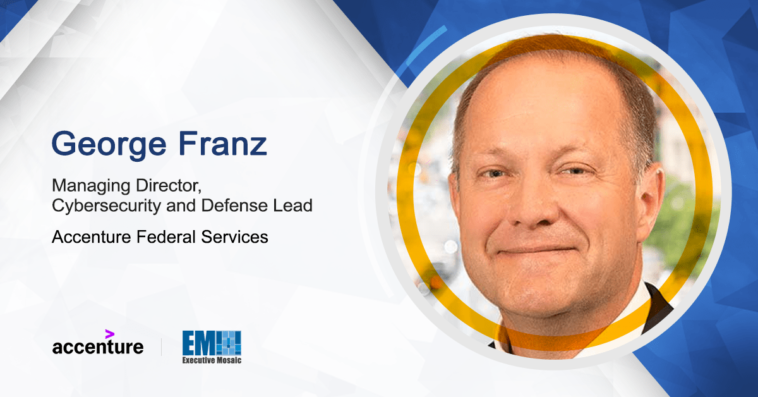Prior to joining Accenture Federal Services, George Franz spent over three decades serving as an intelligence officer in the U.S. Army, during which he held leadership roles in the U.S. Cyber Command, Cyber National Mission Force and Army Intelligence and Security Command.
Franz now leads Accenture Federal Services’ Department of Defense cyber portfolio as a managing director, a position in which he helps educate company clients on cyber threats, risk mitigation opportunities and strategies for improving cyber defenses while guiding defense and security business activities.
In a recent Executive Spotlight interview with ExecutiveBiz, Franz shared his insights on the evolving cybersecurity landscape and its array of new threats, the potential of the Joint Cyber Warfighting Architecture to revolutionize DOD warfighting capabilities and Accenture Federal Services’ role in providing the DOD with the technology necessary to achieve its mission.
Can you talk about how cybersecurity has impacted or changed the national security paradigm? What new trends or shifts are you seeing at the intersection of cybersecurity and national security, and how are those trends influencing the public sector today?
Given the dependence on digital capabilities for almost every aspect of national commerce, defense and governance, cybersecurity is at the heart of national security. Today, the United States is engaged in global cyber conflict with an incredible range of cyberthreat actors, including sophisticated criminal elements, non-nation state and nation state adversaries. We face capable and sophisticated peer nation states waging global campaigns to achieve strategic advantage in cyberspace.
These groups are targeting our critical infrastructure to prepare for potential future conflict, and they are already acting to exploit the upcoming U.S. election to cause social chaos and to attack our democratic institutions. They are continuing to conduct cyber espionage and economic warfare that threatens our industrial base and our ability to maintain technical advantage in potential encounters.
The U.S. government is defending against threat actors who operate unconstrained, have the full benefit of their nations commercial and military industrial/technology bases, operate with fewer rules and outnumber us by orders of magnitude. This is a tough contest. The only way that we can hope to level the playing field and tip conditions in our favor is to deliver the full weight of the U.S. commercial defense industry, Department of Defense, Intelligence Community and academia with a unified team.
To counter and defeat the scale and mass of threats, we must outthink and out imagine the adversaries, and we can do so with design and continuous innovation. We must give our cyber operators the maximum advantages our creative intellect and technology can provide – we stay ahead through critical thinking and imaginative problem-solving. The tools we use to innovate must be so easy to use that teams don’t even need training. This means testing the effectiveness of new ideas and scaling what works at mission speed. We must shift to next generation security technologies that deliver automation and orchestration through security orchestration, automation and response tools and robotic process automation, employing generative artificial intelligence to accelerate threat analysis and cue potential cyber actions to mitigate the reliance on manpower alone for defending and triaging security events.
Where are you seeing the most exciting opportunities to deliver better capabilities to our warfighters today, and how are you harnessing these opportunities?
From a DOD perspective, some of the most significant challenges in delivering better capabilities to warfighters and bringing innovation to the force are not technical. There is a need for new processes and better ways of bringing new technologies into the force in ways that empower the operators and leaders, the Soldiers, Sailors, Airman, Marines, Guardians, Coast Guardsmen and civilians who will be employing the capabilities to accomplish their individual and collective missions.
The Joint Cyber Warfighting Architecture was established by the U.S. Cyber Command to guide development and procurement for the DOD’s global warfighting capabilities. The scale and complexity of this operational construct requires unified governance and leadership at the strategic and operational levels while the dynamic operating environment demands agility, initiative and speed at the tactical level to keep pace with the constantly evolving mission and threats.
As the acquisition of JCWA continues to evolve, the joint governance process must actively engage key stakeholders to validate, support and refine the JCWA vision, roadmap, prioritization and sequencing of its components. This must happen while also taking greater ownership of the larger doctrine, organizational, leadership and policy issues that are required to build, operate and sustain JCWA.
The continued infusion of new leaders among key stakeholders in the JCWA community of interest offers an opportunity to accelerate efforts to design and implement the strategy. Through timely engagement, continuous collaboration and focused group efforts to review, refine and reset JCWA’s vision and strategic road map, DOD leaders and stakeholders can confirm support, uncover divergence, build understanding and gain external advocacy to accelerate the design and implementation of JCWA.
The acceleration of JCWA’s implementation can be enabled through three lines of effort, the first of which is cultural change. Change must be supported by all stakeholders, and because supporting organizations have limited people, time and resources, disciplined collaboration must drive effective and efficient governance. The command must modify and leverage its operational battle rhythm and processes to ensure JCWA acceleration is effectively nested with strategic planning and combat operations. Command, government, industry and academic stakeholders must work as a cohesive team and break down any barriers that limit cooperation. Human-centeredness rests on the concept that unit operators and leaders are the ‘pullers’ of the value through the JCWA acquisition pipeline. The command sets clear strategic and operational priorities that are ‘guardrails’ for agile capability development. ‘Value’ would be defined jointly between what the operational teams experience and what is emerging through command, industry and academia.
Second is Agile Leadership. The Agile Framework for the Enterprise sets the doctrinal conditions and processes for real, disciplined innovation with practical results. By adopting and implementing a Dual Operating Model for JCWA, USCC and the JCWA enterprise can ensure operational and technical agility at the edge while effectively managing the service-like and enhanced authorities for acquisition, requirements, resourcing and strategic command and control.
Headquarters digital transformation marks the third line of effort. Modern mission command requires data-driven decision making and effective administrative control to enable operational control – digital platforms are foundational to data-driven C2. This will include the rapid application of digital platforms, cloud and other emerging commercial capabilities for ADCON, using industry best practices to help accelerate JCWA implementation across the headquarters and with key stakeholders.
By adopting a forward-looking, agile and efficient approach to leading JCWA implementation, USCC will become the nation’s leader in delivering and operating modern digital warfighting capabilities.
What do you think are the most pressing national security threats we’re facing today? How is your organization addressing these threats?
The security environment in the United States today is more diverse and more dangerous than ever. The nation faces a significant number of critical threats from hostile nation states, terrorist organizations and a growing array of hybrid threats that are more complex than we would have imagined a decade ago, linking different adversaries in coordinated campaigns against our national security. These adversaries work across all operational domains from space to sea, air, land and cyberspace, and their employment of commercially available technologies has become a significant threat to our technical advantage.
To successfully defend against these multi-domain threats, the DOD – in partnership with the Intelligence Community and other federal agencies – must provide viable options and capabilities to our policymakers. That means military commanders and law enforcement officials must have access to effective intelligence support and highly-trained and highly-prepared cyber forces able to actively defend our critical assets.
We need to enable situational awareness and full spectrum defensive and offensive capabilities to arm decision-makers with a full range of cyber options in our current volatile security environment. That includes delivering the most up-to-date technologies to improve the ability to withstand potentially devastating attacks.
We know our adversaries are keeping up with advances in technology. It is essential we do better. These new technologies must be woven into our cyber-operational platforms in a way that maintains continuity of operations while allowing for the addition of innovative new capabilities on the fly. The DOD will benefit from continued advances in intelligent automation and generative AI programs that facilitate integration and enhanced decision-making through meaningful data. We will need to incorporate these new capabilities into the JCWA – our cyber mission forces deserve the most effective capabilities that we can bring to the field.
The United States can be counted on for global technological superiority. We must focus on areas where we do hold the advantage: GAI, encryption, robotics, integrated surveillance/sensor technologies, smart platforms, commercial satellites and advanced sensors. Our nation’s ability to continually innovate and adapt is key to maintaining our edge.
As a global leader in digital innovation, Accenture Federal Services is playing a central role in providing the critical readiness support our clients need to implement a modern information technology enterprise, enhanced cyber defenses, advanced analytics, intelligent automation, AI and predictive modeling.
One component of our collaboration with government, academia and industry partners is the annual Federal Technology Vision report, which examines how the top emerging technology trends will impact federal agencies. Our report brings together insight from Accenture Federal Services experts and survey data from 200 federal executives. This 2023 edition builds on the key theme of emerging technologies laying the foundation for a new reality of federal operations – one in which the digital world will be more seamlessly infused throughout the physical one, enabling greater mission outcomes.
In this year’s report, we covered four trends that will be fundamental to this shift. The first is digital identity – the necessary foundational layer to our digital and physical lives. Efforts to reimagine it are underway, not just for people but for all things.
The ‘your data, my data, our data’ trend covers the reshaping of data ecosystems by new approaches to transparency and accessibility as agencies leverage their troves of data to offer unprecedented insight.
Generalizing AI, the third trend, recognizes foundation models as drivers of one of the biggest changes in AI history. Now, agency leaders can shift from building their own AI to building with AI.
The fourth trend, ‘our forever frontier,’ notes that the science-technology feedback loop can give the federal government’s position as a leader in scientific research and development greater impact and scale.
This 2023 Federal Technology Vision is another tool that we can apply to counter and defeat the scale and mass of threats, to outthink and out imagine the adversaries. Design and continuous innovation is the way we outmaneuver and neutralize today’s security threats.





